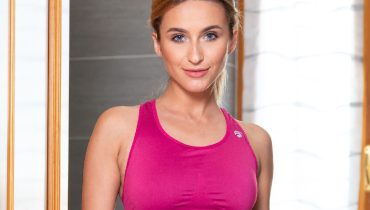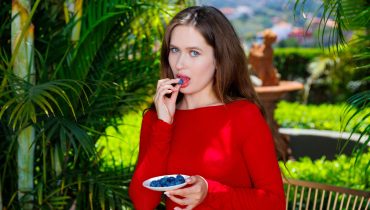When Roux Wells first transitioned to a plant-based lifestyle, she expected to feel lighter and cleaner — but instead, she felt tired, foggy, and constantly hungry. “I thought eating vegan was automatically healthy,” she admits. “But after a few months, I realized I wasn’t getting enough protein.”
That realization sent her on a mission that would reshape not only her diet but her entire relationship with food: crafting high-protein plant-based power lunches that fuel energy, focus, and long-term health without sacrificing flavor.
From Burnout to Balance: Roux’s Journey
Roux’s story began in San Diego, where she juggled long days as a fitness instructor and freelance writer. “I was teaching three classes a day and surviving on smoothies and salads,” she says. “By afternoon, I’d crash hard — caffeine wasn’t cutting it anymore.” She started researching what her body truly needed, and all signs pointed to one nutrient she’d overlooked: protein.
According to the Harvard Health Publishing, protein is essential not just for muscle repair, but for enzyme production, immune function, and hormonal balance. “I used to think protein was only for bodybuilders,” Roux laughs. “Now I know it’s for anyone who wants sustained energy and focus.”
But as a vegan, she faced a unique challenge — getting enough protein without relying on processed meat substitutes. “I didn’t want to live on fake burgers and powders,” she says. “I wanted real, colorful, energizing food.” That desire sparked what she now calls her “power lunch revolution.”
Redefining the Power Lunch
For Roux, a “power lunch” means more than calories. It’s about nourishment, mental clarity, and stamina. “When your midday meal works for you instead of against you, everything changes,” she says. “You’re not crashing at 3 p.m. or reaching for sugar. You’re thriving.”
Her guiding principle became simple: each lunch should provide at least 20 grams of protein, balanced with fiber, healthy fats, and complex carbs. “The protein keeps me full, the fiber regulates digestion, and the fats stabilize energy,” she explains. “It’s science meeting self-care.”
Her recipes soon became a sensation among her students and online followers. “People were shocked when they learned my lunches were completely plant-based — no dairy, no eggs, no meat,” she says. “But they still packed the protein punch of a chicken bowl.”
The Science of Plant-Based Protein
Unlike animal protein, plant protein sources often lack one or more essential amino acids — the building blocks of muscle and tissue repair. “That’s why variety is key,” Roux says. “When you mix legumes, grains, and seeds, you create what’s called a ‘complete protein.’”
According to the U.S. Department of Agriculture (USDA), adult women need around 46 grams of protein daily, while men require about 56 grams. Roux typically aims for 70–80 grams due to her active lifestyle. “The trick is not just hitting the number — it’s spreading it evenly through the day,” she says. “That’s why lunch matters so much.”
Some of her favorite plant-based protein sources include:
-
- Lentils – 18g per cooked cup; versatile, affordable, and full of iron.
-
- Chickpeas – 15g per cup; perfect for bowls, stews, or roasted for crunch.
-
- Edamame – 17g per cup; a complete protein and rich in magnesium.
-
- Quinoa – 8g per cup; contains all nine essential amino acids.
-
- Tofu & Tempeh – 15–20g per serving; excellent for quick stir-fries or meal prep.
-
- Hemp & Chia Seeds – small but mighty, with 5g per tablespoon.
“I combine at least two sources in every meal,” she explains. “For example, quinoa with black beans, or tofu with chickpeas. It keeps flavors interesting and nutrition complete.”
Roux’s Signature Power Lunches
Her weekly meal prep includes five rotating recipes, all customizable depending on the season and budget. “I keep them under 30 minutes to make,” she says. “Because if it’s not easy, it’s not sustainable.”
1. The Mediterranean Power Bowl
Base: quinoa and lentils.
Toppings: roasted red peppers, olives, cucumber, hummus, and lemon tahini dressing.
Protein: ~25g per serving.
“This one’s my favorite for busy Mondays,” Roux says. “The saltiness of olives and the creaminess of tahini make it comforting and bright at the same time.” According to the Healthline, Mediterranean diets are linked to lower inflammation and better heart health — an added bonus.
2. Thai Peanut Crunch Wrap
Base: tempeh stir-fried with shredded cabbage, carrots, and bell peppers.
Sauce: peanut butter, lime juice, soy sauce, and ginger.
Wrapped in: whole-grain tortilla or collard leaves.
Protein: ~28g per wrap.
“The peanut sauce gives you protein and flavor,” Roux explains. “It’s basically a salad in disguise.”
3. Spicy Chickpea Burrito Bowl
Base: brown rice, roasted chickpeas, black beans, corn, avocado, and salsa.
Topped with: cilantro and lime.
Protein: ~30g per bowl.
“This one’s a crowd-pleaser,” Roux says. “It’s filling, affordable, and easy to batch-cook for the week.” The fiber-rich beans also support gut health, which the Mayo Clinic links to stronger immunity and weight management.
4. Green Goddess Protein Pasta
Base: lentil or chickpea pasta tossed with a homemade pesto made from kale, basil, and hemp seeds.
Protein: ~26g per serving.
“This dish changed my opinion about vegan pasta,” she says. “It’s hearty and silky — not a salad pretending to be pasta.”
5. Power Bento Box
Components: edamame, tofu cubes, roasted sweet potato, apple slices, and almond butter.
Protein: ~24g per box.
“This one’s for my teaching days,” Roux explains. “Everything’s bite-sized, quick, and balanced.”
Meal Prep and Time Management
Roux believes that consistency beats complexity. “You don’t need fancy ingredients — just a plan,” she says. Every Sunday, she spends 90 minutes prepping proteins, chopping vegetables, and mixing sauces. “If it’s ready in the fridge, you’ll eat it,” she says. “That’s my golden rule.”
Her secret to freshness? Layering. “Keep sauces separate until lunchtime,” she explains. “It keeps everything crisp.” She also preps grains in bulk using a rice cooker, then rotates toppings to avoid boredom. “I make one base and three variations — Mexican, Mediterranean, and Asian-inspired. Same protein, new flavor.”
She uses airtight glass containers instead of plastic. “They last longer, don’t stain, and make your lunch feel intentional,” she adds. “Food is energy, but presentation is motivation.”
Smart Protein Boosters
For extra protein, Roux sprinkles hemp seeds or nutritional yeast on everything. “Two tablespoons of hemp seeds add 6 grams of protein and omega-3s,” she says. “It’s the easiest upgrade ever.” She also blends silken tofu into dressings for a creamy texture without oil. “It’s a trick I learned from a chef friend — total game-changer.”
The Psychology of Eating Well
As much as Roux focuses on macronutrients, she also emphasizes mindset. “Food is emotional,” she says. “When you eat meals that reflect care, you stop feeling deprived.” She encourages mindful eating — slowing down, savoring flavors, and avoiding distractions. “It’s not about perfection,” she adds. “It’s about attention.”
Her approach aligns with findings from Harvard Health on mindful nutrition, which show that awareness during meals improves digestion and satisfaction while reducing overeating.
Roux also reminds readers that plant-based eating is not a competition. “You don’t have to go 100% vegan overnight,” she says. “Start with one plant-based lunch a day. Let your energy prove it to you.”
Health Benefits Beyond Protein
While protein gets the spotlight, Roux emphasizes that plant-based diets provide a holistic advantage. “You’re also getting antioxidants, vitamins, and phytonutrients that animal-based diets can’t offer,” she explains. The Cleveland Clinic notes that plant-based diets lower inflammation and support cardiovascular health. “That’s the long game,” she says. “Protein keeps you strong today, but plants keep you alive tomorrow.”
She’s noticed other changes too: clearer skin, better focus, and improved sleep. “It’s amazing how quickly your body rewards you when you feed it well,” she says. “You can literally feel the difference.”
Overcoming the Myths
Roux often hears people say plant-based diets are “too expensive” or “not filling.” She disagrees. “Beans, lentils, and grains are some of the cheapest foods on earth,” she says. “The key is learning to cook them well.” She uses spices like turmeric, smoked paprika, and cumin to bring flavor without sodium. “Your taste buds adapt,” she says. “Now, I crave real food.”
As for fullness, she says it’s all about balance. “Add healthy fats like avocado or nuts, and fiber from vegetables. That combo keeps you satisfied for hours.”
Roux’s Daily Routine
Her mornings start with lemon water and a 20-minute walk. “Movement wakes up my digestion,” she says. Breakfast is light — a smoothie with spinach, banana, and vegan protein powder. Lunch, however, is the main event. “It’s my anchor meal,” she explains. “It determines how my day flows.”
Each afternoon, she takes a short break from work to enjoy her prepped lunch — no screens, no multitasking. “It’s 20 minutes of peace,” she says. “When you eat with presence, you digest with gratitude.”
She ends her day with herbal tea and journaling — not for productivity, but reflection. “Food is part of my self-respect now,” she says. “That’s something no calorie count can measure.”
What Roux Wants Others to Know
“Switching to plant-based eating isn’t about restriction — it’s about liberation,” Roux says. “You stop relying on processed foods and start building meals from real ingredients.” Her hope is to inspire others to see food as a tool for creativity, not control. “Cooking used to stress me out,” she admits. “Now it’s my meditation.”
Her advice for beginners: start simple. “Don’t overcomplicate it. Pick two proteins, two grains, and two sauces you love. Rotate them weekly. Within a month, you’ll have your rhythm.”
Final Thoughts
Roux’s journey is proof that health doesn’t have to be hard — just intentional. By focusing on high-protein plant-based lunches, she not only rebuilt her energy but also her sense of joy. “Food is fuel, but it’s also identity,” she says. “Every meal is a vote for the kind of life you want.” Her favorite quote, which she keeps taped to her fridge, sums it up perfectly: “Eat like you love yourself.”




























































